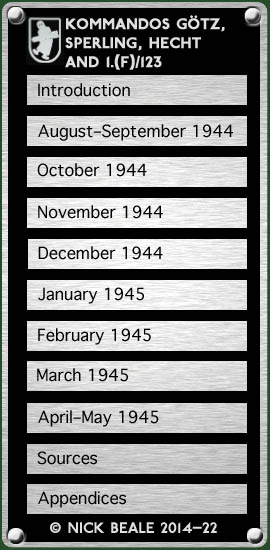|
A clue that Allied airfields remained an important objective for the Arados came on the 19th in a message, very little of which was intercepted, to the two Kommandos, giving new code numbers for Metz, Moerchingen-North and Sandweiler. Operational Watch’s summary for the day included: (a) Single operation by Det. Hecht, 1 Me 262 [sic] up 10.50, down 12.22, visual recce of Maas bridges and PR Namur – Givet, and road recce (to establish whether Allies were bringing up fresh forces) in Bastogne – Dinant area, including P/R of traffic near Marche carried out. Traffic movements observed. (b) Bastogne Station apparently covered … but possibly not by Det. Hecht. (c) St. Trond – Huy – Malmedy area apparently covered. [Jagdkorps] II aware by 13.00 that Allied armoured div. was coming up on this line. Among the important observations from this flight for the German offensive were that the road bridges at Namur, Dinant and Givet were in use while a railway bridge 3 km south of Dinant had been destroyed and one 10 km north of the town was being repaired. There was heavy lorry traffic heading for Namur and Marche but no tanks were spotted. Meanwhile, Kdo. Sperling was again grounded by the winter weather. The Allies did not detect any reconnaissance sorties on the 20th; the following day II. Jagdkorps reported that there had been no operations owing to persistent bad weather, and the situation for the two Kommandos was no better on the 22nd. On 23 December Sperling and Hecht’s objectives were to supplement II. Jagdkorps’ reconnaissance efforts by: (a) P/R’s road Hasselt – Liège, Ourthe to Hotton, Hotton – Marche – Libin – Libramont – Neufchateau – Arlon – Luxembourg – Mersch. (b) P/R’s road Aachen – Liège – Huy – Marche – Ciney – Namur – Meuse as far as Givet; Givet – Rochefort. (c) Alternative target in case of bad weather probably as on 21/12 as far as Antwerp along Scheldt. From 10.58–12.40 hrs. Horst Götz (T9+GH) attempted a reconnaissance of the area Liège – Namur – Mersch but was hampered by very poor visibility (to the extent that he was unsure exactly what route he had taken) and by a heavy presence of Allied fighters and four-engined bombers. Werner Muffey (T9+KH) tried again from 12.08–13.50 hrs. but was thwarted by heavy mist, He was however successful in photographing Antwerp and the Scheldt, a courier fetching his films shortly after he landed. Both GH and KH were reported unserviceable by mid-afternoon. Accordingly the day’s assignments were reiterated for the 24th. At 12.45 hrs. on the 24th, Erich Sommer took off from Biblis in T9+IH but was unable to return there because it had been badly bombed in his absence. He found three alternative aerodromes in a similar state and, low on fuel, attempted a landing at Wiesbaden-Erbenheim at 14.25 hrs. only for his aircraft to be fired on by the base’s Flak gunners and set on fire. Nevertheless he was able to make an emergency landing, get out unhurt and save his film magazines. Kommando Sperling radioed to ask whether IH was repairable and what percentage damage it had suffered. In reply, Sommer advised that the front fuel tank and centre section were burnt out and the machine must be sent to the workshop for repair. Next, he was asked what specialists and equipment would be needed to strip T9+IH and Sommer replied that a lorry should be sent to Erbenheim the next morning. Meanwhile, GH was having its port engine changed. On Christmas Day it was decided that all the reconnaissance Ar 234s should operate from Rheine for the time being and orders were given by Oberst i.G. Seeliger (Operations Officer with Lw. Kdo. West) that once reinforcements arrived, Sperling should always hold one pilot at readiness for V-2 spotting over Antwerp, “in accordance with oral instructions to Hptm. Götz.” Muffey (T9+KH) was in the air from 08.40–10.00 hrs. From a cloudless sky his photographic mission took him over Düren – Aachen – Liège – Andenne – Marche – Verviers – Aachen – Gemünd – Monschau – Aachen – Maastricht – Roermond – Venlo and Geldern. Ziese (T9+HH) was up just two minutes later on the same task. By the time he landed (at 10.26 hrs.) he had covered the route Venlo – Liège – St. Trond – Louvain – Malines – Antwerp – Westerschelde – the Moerdijk district – Breda – Tilburg – ’s Hertogenbosch and Nijmegen. Erich Sommer meanwhile was travelling by car to visit the Photographic Section of Lw.Kdo. West which was asked to hold back Sperling’s courier vehicle until he got there. On 26 December Werner Muffey (T9+KH) carried out a mission assigned a week previously: from 10.15–12.10 hrs. he photographed the English east coast from Southwold to Dover then back across the Channel to Boulogne, Calais, Dunkirk, Ostend, Zeebrugge, the Western Scheldt and Antwerp. Wolfgang Ziese (T9+HH) was up on V-2 observation from 12.29–13.15 hrs. Over Antwerp he observed the first impact at 13.07 hrs., 7.5 km. SSW of the city centre, west of the Willebroek road; the second came four minutes later, in the angle of the Turnhout–Maas canal, 7.5 km. ENE of the centre. The third rocket fell at 13.14, reportedly 30 km. ENE of Rijkevorsel (although it seems possible that the intended meaning was Rikevorsel, 30 km. ENE of Antwerp). Photos were taken of the impact points and of the Scheldt as far as Vlissingen, and of Antwerp, Breda, Tilburg, ’s Hertogenbosch and Nijmegen. BP passed this data to the Air Ministry’s “Crossbow Watch” (the branch monitoring German V-weapons) and to Dr. R.V. Jones at the Secret Intelligence Service’s Broadway Buildings HQ. continued on next page …
|
||

